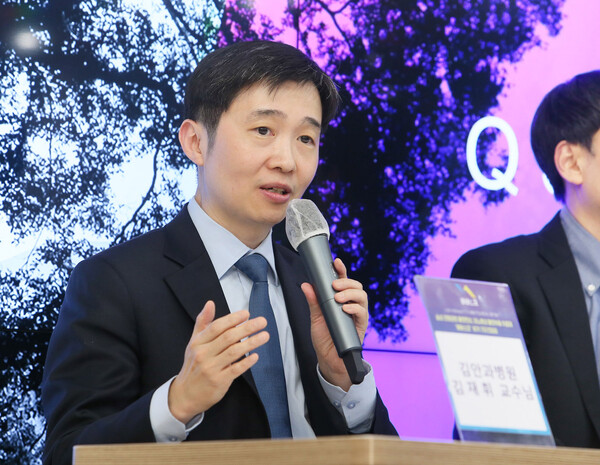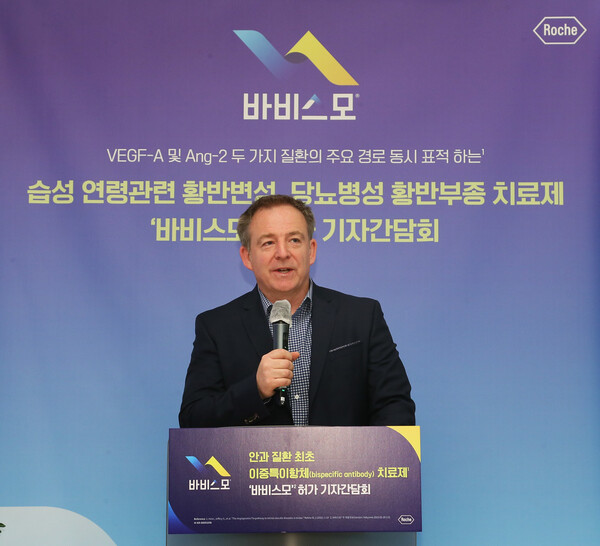Vabysmo (faricimab) of Roche Korea comes to Korea as a new ophthalmological drug, which is good news for the nation’s older adults with eye problems.

It is the only injectable treatment approved simultaneously for wet age-related macular degeneration (nAMD) and diabetic macular edema (DME), the two leading causes of blindness, said an expert.
Aiming to bring changes to the retinal vein occlusion (RVO) treatment field, Roche Korea announced the launch of Vabysmo to treat both groups in a news conference held at its headquarters in Seoul Tuesday. It increased the number of degeneration treatments in Korea to four, including Bayer’s Eylea and Novartis’ Beovu and Lucentis.
Vabysmo won regulatory approval in Korea on Jan. 20 for nAMD and DME and is the first bispecific antibody for eye diseases. It targets and inhibits two signaling pathways linked to several retinal conditions by neutralizing angiopoietin-2 (Ang-2) and vascular endothelial growth factor-A (VEGF-A).
The two proteins contribute to vision loss by destabilizing blood vessels, causing leaking and inflammation. By blocking both pathways involving Ang-2 and VEGF-A, Vabysmo is designed to stabilize blood vessels.
Professor Kim Jae-hui, an opthalmologist at Kim’s Eye Hospital and a member of the Korea Retina Society, presented the current situation of nAMD/DME treatment and its limitations, stressing the need for new drugs like Vabysmo supported with clinical evidence.
Professor Kim highlighted patients’ social and economic burden for current treatments.
“Current anti-vascular endothelial growth factor (anti-VEGF) intravitreal (IVT) injections only inhibit VGEF and should be injected for an extended period and frequently (every four to eight weeks), compared to every 16 weeks with Vabysmo to maintain vision and anatomical improvements.
He added that real-world data also showed it is often difficult to reproduce the results found in clinical settings as patients cannot visit hospitals as frequently as required.
In this regard, Kim noted the benefits of Vabysmo in reducing the number of doses administered with more prolonged treatment effects, along with the identified effectiveness and safety profile.
“In four large global clinical studies involving more than 3,000 nAMD and DME patients, Vabysmo confirmed effective vision maintenance and improvement can be achieved by extending treatment intervals up to 16 weeks when administered at least three times a year,” he said.
Kim specifically pointed to the TENAYA and LUCERNE clinical studies carried out for the nAMD indication of Vabysmo and YOSEMITE and RHINE trials for treating DME, where about 60 percent of patients showed a sustained improvement effect for four months.
It also showed rapid improvement in anatomical changes as the basis for treatment. In eye diseases, anatomical indicators like central subfield thickness (CST) are associated with visual acuity and a thicker CST is associated with more visual impairment.

The TENAYA and LUCERNE study also showed that 75 percent of patients lost intra-retinal fluid (IRF)/sub-retinal fluid (SRF) after the initial two doses. After one year of receiving doses at four-month intervals, patients' CST decreased to similar levels as those in the aflibercept control group.
Likewise, the YOSEMITE and RHINE study noted similar vision and anatomical gains for Vabysmo as a DME treatment. Additionally, no new or unexpected adverse events were observed. Similar levels of ocular-related adverse events were identified compared to aflibercept.
“Fewer treatments signals good news for insurance which is not always easy to obtain,” Professor Kim said.
Roche Korea expressed its company’s intention to quickly apply for insurance benefits, emphasizing that it has been approved in more than 50 countries worldwide and is receiving insurance benefits in several countries, including Australia.
Roche Korea General Manager Nic Horridge also said, “This is an important medicine for us not just because of the value it brings to patients but also because we want to continue expanding our ophthalmological pipelines in the years to come."
Related articles
- Parkinson's disease patients call for a resupply of Madopar
- Roche’s lung cancer drug Alecensa proves safety, effects on Korean patients
- Roche withdrew Tecentriq’s indication for bladder cancer in US. What about Korea?
- Roche Korea’s lymphoma drug wins 1st ‘GIFT’ designation
- Vabysmo proves effective for polypoidal choroidal vasculopathy patients, including Koreans

